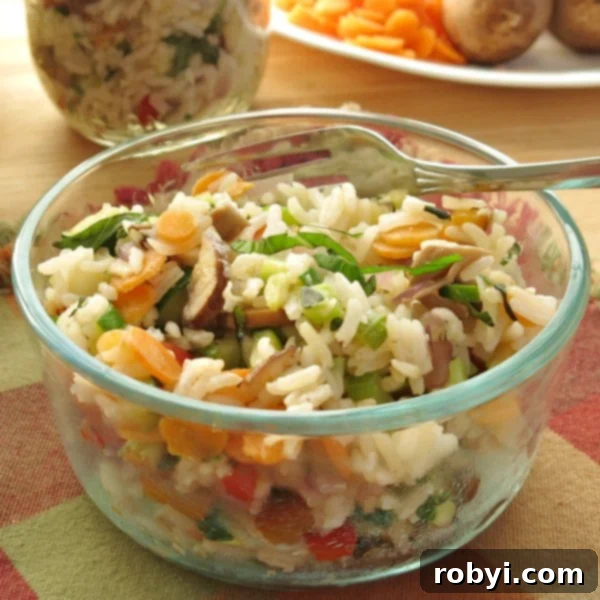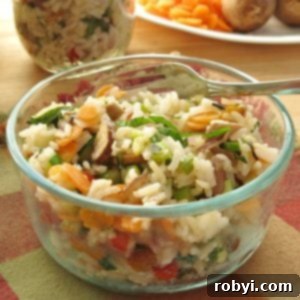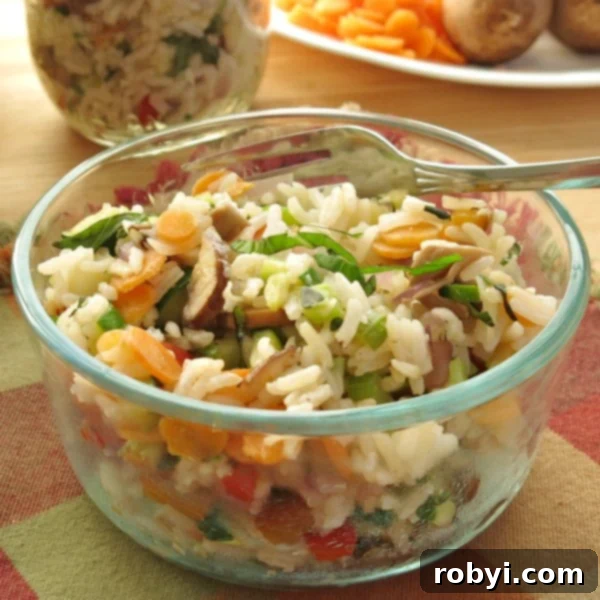Transform your weekly meal planning with our vibrant and versatile Vegetable Rice Pilaf. This recipe isn’t just a side dish; it’s a foundation for countless healthy and delicious meals. Imagine your refrigerator and freezer stocked with this colorful, nutrient-rich pilaf, ready to be enjoyed whenever hunger strikes. Whether you serve it alongside your favorite protein or make it the star of a hearty rice bowl, this pilaf offers both convenience and a burst of fresh flavors.

What Makes a Perfect Vegetable Rice Pilaf?
At its heart, rice pilaf is a dish where rice is sautéed in oil or butter, often with aromatics, before liquid is added. This technique toasts the rice grains, preventing them from clumping and resulting in a fluffy, distinct texture. Our vegetable rice pilaf elevates this classic by infusing it with a medley of fresh vegetables and aromatic herbs, creating a dish that is both satisfying and incredibly wholesome. Unlike plain boiled rice, pilaf offers a depth of flavor and texture that can truly complement any main course or stand on its own.
This particular recipe draws inspiration from the rich, flavorful tradition of Cajun Dirty Rice, but with a lighter, herbaceous twist. We swap the bold Cajun spices for the fragrant notes of basil and thyme, creating a distinctly fresh and milder profile that appeals to a wider range of palates. Both versions are undeniably delicious, offering unique culinary experiences.
For those colder months, another comforting favorite we often turn to is our Farro Pilaf, studded with cranberries and walnuts. The choice between these delightful pilaf variations in our home often depends on the season, our mood, and the company we’re entertaining.
The Art of Crafting Homemade Vegetable Rice Pilaf
Creating this flavorful vegetable rice pilaf is a straightforward process, breaking down into three core components. The beauty of this recipe lies in its simplicity and the ability to customize it to your taste and what you have on hand.
- Perfecting the Rice Base: The journey begins with cooking your chosen rice. While traditional long-grain varieties like Basmati or Jasmine are excellent for their distinct texture and aroma, don’t hesitate to experiment. Brown rice works wonderfully, adding a nutty flavor and extra fiber. For enhanced flavor from the get-go, we highly recommend using vegetable broth instead of plain water. This simple swap infuses every grain of rice with savory goodness. You can prepare the rice using your preferred method, whether it’s on the stovetop, in a pressure cooker, or even a dedicated rice cooker for ultimate convenience.
- Sautéing the Aromatic Vegetables: The heart of this pilaf’s flavor comes from finely diced and perfectly sautéed vegetables. Our go-to combination includes carrots, onions, celery, bell peppers, and mushrooms, forming a robust and colorful base. However, this is where your creativity can truly shine. Feel free to incorporate whatever seasonal produce you have available or that catches your eye at the market. Consider adding zucchini, peas, corn, or even a handful of spinach or kale towards the end for an extra nutritional boost. The key here is to dice the vegetables finely to ensure they cook evenly and integrate seamlessly with the rice.
- Bringing It All Together: Once your rice is cooked to fluffy perfection and your vegetables are tender and fragrant, the final step is to gently combine them. This rice pilaf recipe embraces simplicity, using readily available ingredients you likely already have in your pantry and refrigerator.
While the basic recipe stops at this delicious combination, feel free to take it further with optional toppings and mix-ins. Elevate the texture and flavor by adding toasted nuts like pine nuts or slivered almonds, dried fruits such as cranberries or apricots for a touch of sweetness, or a sprinkle of other fresh herbs like parsley or dill. And, of course, there’s cheese! Parmesan cheese is a non-negotiable at my house, adding a salty, umami kick. For my vegan daughter, a generous sprinkle of nutritional yeast provides a delightful cheesy flavor without any dairy.

The Power of Meal Prep: Assembling Your Vegetable Rice Pilaf for Storage
My culinary philosophy revolves around the mantra: “Cook once, eat twice… or even three times!” This principle is perfectly embodied by this vegetable rice pilaf. It’s an ideal candidate for meal prepping, saving you invaluable time and effort during busy weekdays. Consider doubling or even tripling the recipe; the effort involved in making a larger batch of rice is minimal, and while the chopping might take a little extra time, it’s incredibly efficient since all your tools and ingredients are already out. The payoff in convenient, healthy meals throughout the week is immeasurable – truly worth every minute spent!
This strategic approach to cooking is the same thinking we apply to making our Homemade Vegetable Soup, ensuring a steady supply of nutritious options. This batch of vegetarian rice pilaf, for instance, was prepared specifically with storage in mind. Pictured is my organized assembly line of mason jars and glass bowls, ready to be filled. And since my indoor thyme plant has been thriving lately, I brought a sprig inside to adorn the freshly prepped containers, adding a touch of garden-freshness.

Storage and Reheating Tips for Maximum Freshness
Once prepared and portioned, your vegetable rice pilaf bowls or jars will maintain their freshness beautifully in the refrigerator for approximately 3 days. This makes them perfect for grab-and-go lunches or quick weeknight dinners. For any portions beyond that timeframe, freezing is an excellent option. Simply transfer the pilaf to airtight plastic freezer bags or freezer-safe containers. When you’re ready to enjoy the frozen rice pilaf, you can defrost it gently in the microwave or allow it to thaw overnight in the refrigerator for best results.
To ensure your reheated pilaf retains its delicious texture and doesn’t dry out, always add a small amount of broth or water to moisten it before heating. For a single serving, just a teaspoon of liquid is usually sufficient. This small step makes a significant difference, restoring that light and fluffy consistency as if it were freshly made.

There’s a genuine peace of mind that comes from knowing you have jars of this wholesome vegetarian rice pilaf tucked away, ready to serve at a moment’s notice. It simplifies healthy eating and ensures you always have a nutritious option within reach.
Craving more easy, healthy, and carb-conscious recipes?
📋 Recipe: Flavorful Vegetable Rice Pilaf

Vegetable Rice Pilaf Recipe
★
★
★
★
Print Recipe
Pin Recipe
Rate This Recipe
10 minutes
20 minutes
30 minutes
6
sides
Marjory Pilley
Save this recipe and get new recipes sent to your inbox each week!
Click here to subscribe!
Ingredients
- 1 cup long grain brown rice such as jasmine or basmati
- 1 ½ cups vegetable broth low sodium
- 1 Tablespoon olive oil
- 1 Tablespoon butter or vegan substitute
- 1 cup onion diced; 1 medium sized onion
- 1 cup celery diced; about 2 celery stalks
- 1 cup carrots sliced; about 2 carrots
- 1 cup red pepper diced; about 1 red pepper
- 4 ounces mushrooms chopped
- 3 garlic cloves minced
- 1 Tablespoon fresh thyme leaves
- Salt and pepper to taste
- ¼ cup fresh basil cut into strips
- ¼ cup freshly grated Parmesan optional
Instructions
- Cook rice according to package instructions, using vegetable broth instead of water. The rice should be light and fluffy, with all the broth absorbed, when finished.
- Heat olive oil and butter (or vegan substitute) in a large skillet or pan over medium heat.
- Add the diced onion, celery, carrots, bell pepper, mushrooms, and minced garlic to the pan. Sauté the vegetables, stirring occasionally, until they are soft and tender-crisp, which usually takes about 5-7 minutes.
- Once the rice is fully cooked, add it to the pan with the sautéed vegetables. Gently mix everything together until well combined.
- Stir in the fresh thyme leaves. Season generously with salt and black pepper to taste, adjusting as needed.
- Serve warm, garnished with fresh basil strips and a sprinkle of Parmesan cheese (if using).
Last Step
Please leave a rating and comment! Your feedback helps our business thrive and allows us to continue providing more free recipes.
Notes
Grab 5 Low-Carb Sauces
and get more easy, healthy recipes! JOIN HERE
Nutrition Information (per serving)
Calories:
191
kcal
|
Carbohydrates:
32
g
|
Protein:
4
g
|
Fat:
5
g
|
Saturated Fat:
1
g
|
Cholesterol:
5
mg
|
Sodium:
285
mg
|
Potassium:
345
mg
|
Fiber:
3
g
|
Sugar:
4
g
|
Vitamin A:
4710
IU
|
Vitamin C:
38.4
mg
|
Calcium:
38
mg
|
Iron:
1
mg
Nutritional and Food Safety Disclaimer
